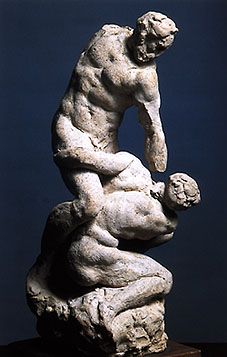In 2009, the art historian William Wallace published an article titled, "Michelangelo: Separating Theory and Practice." Wallace observed that Michelangelo regularly changed his mind in the course of carving his sculptures. He abandoned more than a third of all the sculptures he began, and in the last three decades of his life completed only three. Vasari wrote that Michelangelo was never satisfied with anything he did, and that when "he saw the slightest error he would abandon it and run to start working on another block, trusting that it would not happen again." But it clearly did: Juergen Schulz has estimated that "nearly three-fifths of Michelangelo's sculptures remain unfinished."

Michelangelo frequently changed his sculptures as he worked. Vasari noted that his technique reflected his anticipation of changes in progress, as he wrote that Michelangelo taught other sculptors "how to carve figures... so that they may always be carefully improved by carving away some of the marble while having enough for redesigning or altering the piece as is sometimes necessary." Marble is not a material that readily forgives pentimenti, for every change leaves less marble for the sculptor to work. Some of Michelangelo's greatest sculptures may have remained unfinished because he ran out of stone owing to changes he made in progress.
A powerful tradition in art history characterizes Michelangelo's conception of sculpture according to a metaphor developed by Vasari, that describes the carving as "a gradual issuing forth from the block, like a figure that emerges as it is raised little by little from a tub of water." According to this tradition, Michelangelo "saw the completed figure within the block of marble and proceeded to liberate it by removing the excess stone." A typical product of this tradition is the argument of Rudolf Wittkower that Michelangelo failed to complete his sculptures because of the gulf "between the purity of the Platonic idea and the baseness of its material realization."
William Wallace rejects this traditional conception. He contends that inspection of Michelangelo's works leads to the conclusion that "his approach to sculpture was more practical than theoretical, as tactile as it was cerebral." For Wallace, Michelangelo's "was a visual and manual intelligence in which the creative process involved discovery, revision, and continuous evolution, driven as much by marble as theory and metaphor," and he explicitly describes Michelangelo's as an experimental approach, "characterized by constant revision and a 'lack of a clear vision of the final form of the image -- which is only discovered in the working process.'" This characterization explains why, in spite of his remarkable ability, Michelangelo was rarely if ever satisfied with his works, for he could never reach the vague and elusive visual goals he sought. Wallace's conclusion about Michelangelo as a sculptor: "Mastery was hard earned and never easy, less a theory than a product of experience and a lifetime dedicated to manual work." Michelangelo himself appears to have understood the creative life cycle of the experimental innovator, as he wrote in a poem that "no one has mastery before he is at the end of his art and his life."
Image of Michelangelo's Due lottatori (ca. 1530), courtesy of Casa Buonarroti museum, Florence, Italy
